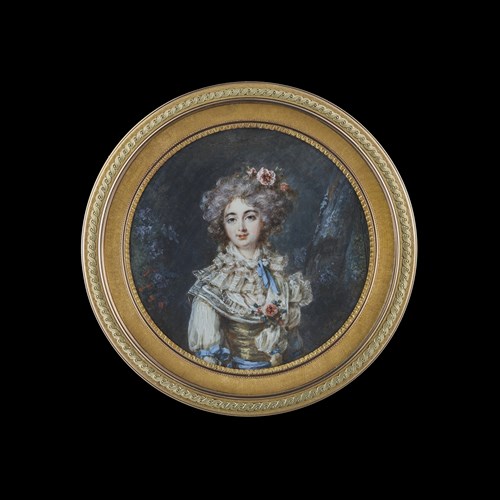Marketplace
A Gentleman, traditionally called Charles Fleetwood, later Lord Fleetwood (circa 1618-1692), wearing armour and lawn collar; circa 1655
JOHN HOSKINS the Younger
A Gentleman, traditionally called Charles Fleetwood, later Lord Fleetwood (circa 1618-1692), wearing armour and lawn collar; circa 1655
The Limner Company : Portrait Miniature
Date Circa 1655
Medium Watercolour on vellum
Dimension 5.7 cm (2¹/₄ inches)
The previous identification of this miniature portrait stems from an inscription on the reverse of the original backing, which appears to have been added at a later date. Identifying the portrait as one of General Charles Fleetwood, it is probable that this name was added to the miniature during the nineteenth century, when interest in the interregnum and Oliver Cromwell experienced a revival. Fleetwood was one of the Lord Protector’s most notorious generals, as well as his son-in-law. He had fought at Naseby (1645), Dunbar (1650), and Worcester (1651), and played a major role in governing England when Cromwelll became the Lord Protector. Comparisons to known portraits of Fleetwood, by Samuel Cooper (1607/8-1672)[1] and Thomas Flatman (1635-1688)[2], indicate that this is not the name of the gentleman portrayed here.
The painter of this portrait was John Hoskins the Younger, son of the well-known elder artist. For a long time, differentiating the hands of the two was seen as almost impossible. The younger is believed to have worked in his father’s studio for over ten years as an apprentice before being employed as an assistant.[3] Compared to his father, John Hoskins the Younger lived in a far more peaceful and politically stable climate. Hoskins the Elder was employed by the Court before the outbreak of the English Civil War and had adapted to paint during the war, capturing those on opposing sides and then into the Interregnum.
Hoskins the younger was likely taught the art of limning alongside his older cousin Samuel Cooper. The similarity between their styles attests to this, but Cooper soon became the most sought-after miniaturist in England and garnered an International reputation. The workshop of Hoskins, which had been so successful during the reign of Charles I, suffered from the success of its most promising pupil. Family loyalty to Hoskins the elder might be behind the commission of this officer, painted against a distinctive half-sky blue background.
[1] Yale Center for British Art, accession number B1974.2.12.
[2] Rosenbach Foundation, Philadelphia.
[3] E Rutherford, et. al. Warts and All: The Portrait Miniatures of Samuel Cooper, London, Philip Mould & Company, 2013, p.98.
The painter of this portrait was John Hoskins the Younger, son of the well-known elder artist. For a long time, differentiating the hands of the two was seen as almost impossible. The younger is believed to have worked in his father’s studio for over ten years as an apprentice before being employed as an assistant.[3] Compared to his father, John Hoskins the Younger lived in a far more peaceful and politically stable climate. Hoskins the Elder was employed by the Court before the outbreak of the English Civil War and had adapted to paint during the war, capturing those on opposing sides and then into the Interregnum.
Hoskins the younger was likely taught the art of limning alongside his older cousin Samuel Cooper. The similarity between their styles attests to this, but Cooper soon became the most sought-after miniaturist in England and garnered an International reputation. The workshop of Hoskins, which had been so successful during the reign of Charles I, suffered from the success of its most promising pupil. Family loyalty to Hoskins the elder might be behind the commission of this officer, painted against a distinctive half-sky blue background.
[1] Yale Center for British Art, accession number B1974.2.12.
[2] Rosenbach Foundation, Philadelphia.
[3] E Rutherford, et. al. Warts and All: The Portrait Miniatures of Samuel Cooper, London, Philip Mould & Company, 2013, p.98.
Date: Circa 1655
Medium: Watercolour on vellum
Signature: Inscribed verso, in a later hand, ‘11 / General Fleetwood’
Dimension: 5.7 cm (2¹/₄ inches)
Provenance: Sotheby’s, London, 6 June 2007, lot 153 (as Portrait of an Officer);
Private Collection, UK.
Plus d'œuvres d'art de la Galerie


, wearing armour and lawn c_T638814186138917415.JPG?width=2000&height=2000&mode=max&scale=both&qlt=90)


_T638865288130600508.jpg?width=500&height=500&mode=pad&scale=both&qlt=90&format=jpg)
 Way (1746-1825), in a pearl-bordered cream silk dress with a fur-bordered pink surc_T638862583741236481.JPG?width=500&height=500&mode=pad&scale=both&qlt=90&format=jpg)


, wearing a decorated doublet under an armour breastplate, the blue sash of the order of the garter,_T638814186128307406.JPG?width=500&height=500&mode=pad&scale=both&qlt=90&format=jpg)